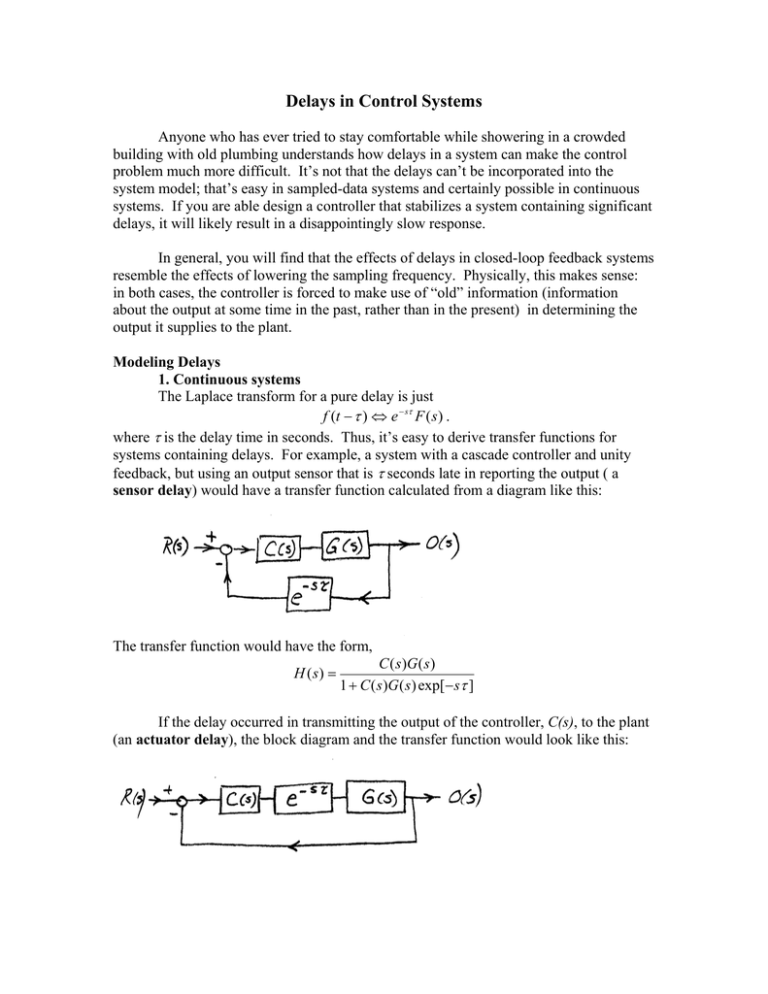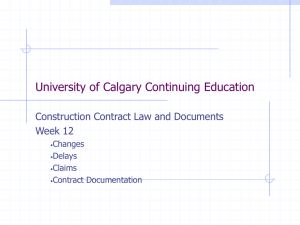Delays in Control Systems: Modeling & Design
advertisement

Delays in Control Systems
Anyone who has ever tried to stay comfortable while showering in a crowded
building with old plumbing understands how delays in a system can make the control
problem much more difficult. It’s not that the delays can’t be incorporated into the
system model; that’s easy in sampled-data systems and certainly possible in continuous
systems. If you are able design a controller that stabilizes a system containing significant
delays, it will likely result in a disappointingly slow response.
In general, you will find that the effects of delays in closed-loop feedback systems
resemble the effects of lowering the sampling frequency. Physically, this makes sense:
in both cases, the controller is forced to make use of “old” information (information
about the output at some time in the past, rather than in the present) in determining the
output it supplies to the plant.
Modeling Delays
1. Continuous systems
The Laplace transform for a pure delay is just
f (t − τ ) ⇔ e − sτ F ( s ) .
where τ is the delay time in seconds. Thus, it’s easy to derive transfer functions for
systems containing delays. For example, a system with a cascade controller and unity
feedback, but using an output sensor that is τ seconds late in reporting the output ( a
sensor delay) would have a transfer function calculated from a diagram like this:
The transfer function would have the form,
H ( s) =
C ( s )G ( s )
1 + C ( s )G ( s ) exp[− sτ ]
If the delay occurred in transmitting the output of the controller, C(s), to the plant
(an actuator delay), the block diagram and the transfer function would look like this:
with H(s) given by
H ( s ) = exp[− sτ ]
C ( s )G ( s )
.
1 + C ( s )G ( s ) exp[− sτ ]
Note that the second transfer function is just a delayed version of the first. Specifically,
in the frequency domain, the gain vs. frequency curves will be the same for both.
The biggest obstacle to handling delay in design is not in the modeling, which you
can see is quite simple: the problem lies in the fact that the delay cannot be expressed as
a rational polynomial. There are some approximations that have rational polynomial
forms:
( sτ ) 2 ( sτ ) 3
exp{− sτ } ≅ 1 − sτ +
−
...... , or
2
6
1
, or
( sτ ) 2 ( sτ ) 3
1 + sτ +
+
...
2
6
1 − sτ
2 , or
exp{− sτ } ≅
1 + sτ
2
1
.
exp{− sτ } ≅
n
⎡ sτ ⎤
⎢1 + n ⎥
⎣
⎦
The last of these can be made as accurate as needed by choosing n large enough.
exp{− sτ } ≅
A little experimentation with your design software will illustrate the strengths and
weaknesses of these approximations. To be “valid” for a particular design, the
approximation you use should accurately track (in both magnitude and phase) the Bode
plot of exp{jωτ}over the range of frequencies corresponding to the bandwidth of the
designed system.
2. Sampled-data systems
Suppose we consider the sampled-data system with actuator delay below:
It has a z-domain transfer function,
H ( z) =
Q( z )
, where
1 + Q( z )
z − 1 ⎧ C ( s )G ( s ) exp[− sτ ] ⎫
− N z − 1 ⎧ C ( s )G ( s ) ⎫
ℑ⎨
ℑ⎨
⎬≈z
⎬ , and
z
s
z
s
⎩
⎭
⎩
⎭
N = f sτ is the (necessarily integer) number of sample periods in the delay, τ.
The importance of the above result is that even with delay, the rational polynomial
nature of the transfer function is preserved in the z-domain. This means we can use
sampled-data design techniques on continuous systems with delays, provided we set the
sampling frequency, fs, high enough to force the sampled-data system to approach the
continuous one.
Q( z ) =
A more general sampled-data system with both actuator and sensor delays is
shown below.
In this system, C(s) and its digital equivalent, D(z), are the only parts of the system
subject to alteration by the designer. When working in the z-domain, we can only
express delays in terms of an integral number of sample periods, i.e.:
• N A = f sτ A is the (integer) number of sample periods in the actuator delay time,
τA, and
• N S = f sτ S , is the (integer) number of sample periods in the sensor delay time, τS.
Applying the general procedure for finding the transfer function of closed-loop systems
yields the z-domain transfer function as
⎛ z − 1 ⎞ ⎧ C ( s)G ( s ) ⎫
z −N A ⎜
⎟ℑ⎨
⎬
O( z )
z ⎠ ⎩
s
⎭
⎝
H ( z) =
=
, where
R( z )
− ( N A + N S ) ⎛ z − 1 ⎞ ⎧ C ( s )G ( s ) ⎫
1+ z
⎜
⎟ℑ⎨
⎬
s
⎭
⎝ z ⎠ ⎩
System design with delays
1. Continuous systems
You can incorporate any rational polynomial approximation for a delay into the
transfer functions for the plant or the feedback loop, and then procede with the design
process as you would have done in the absence of any delays. When you are finished
with the design, you should check the approximation for G(s) you used in the frequency
domain to see that its Bode plot closely follows one for G(s) exp{-jωτ} over all
frequencies within the bandwidth of the design.
Alternatively, and perhaps more safely, you can design your continuous system in
the z-domain, where delays can be modeled exactly, provided you use a high sampling
frequency. In the limit of very large sampling frequency, the sampled-data system will
perform like the continuous one.
If you use the z-domain design approach, you can start your design process
neglecting delays and introduce them gradually in order to see how delay degrades the
performance of the closed-loop system.
2. Sampled-data design
In addition to being useful in the design of continuous systems containing delays,
as discussed above, sampled-data design techniques are of course necessary for systems
where the controller will be implemented digitally. Because the z-domain parameters of
controllers vary as sampling frequency is changed, it will be more convenient to design
the controller in the s-domain and then transform it to the equivalent z-domain transfer
function, D(z).



